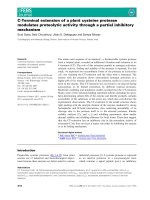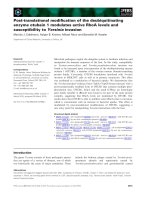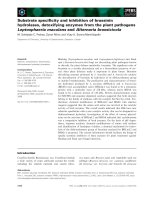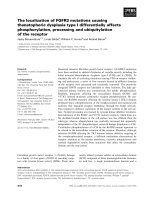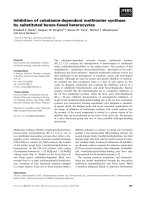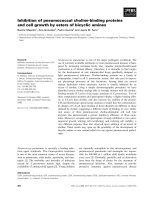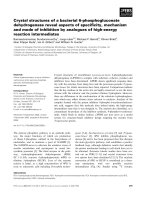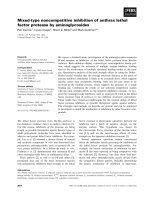Expectation of reward differentially modulates executive inhibition
Bạn đang xem bản rút gọn của tài liệu. Xem và tải ngay bản đầy đủ của tài liệu tại đây (1 MB, 10 trang )
Herrera et al. BMC Psychology
(2019) 7:55
/>
RESEARCH ARTICLE
Open Access
Expectation of reward differentially
modulates executive inhibition
Paula M. Herrera1,2,3,6* , Alberto Vélez Van Meerbeke2, Mario Speranza3,6, Claudia López Cabra2, Mauricio Bonilla4,
Michaël Canu5 and Tristan A. Bekinschtein3
Abstract
Background: Inhibitory control, a key modulatory component of cognition guiding strategy and behaviour, can be
affected by diverse contingencies. We explore here the effect of expectation of reward over behavioural adjustment
in a Stop Signal Task modulated by reward. We hypothesize that cognitive control is modulated by different
expectation of the reward.
Methods: Participants were allocated to two groups differing in their degree of knowledge in what to expect from
rewards. Expected Specific Reward participants (N = 21) were informed of the different monetary feedbacks they
would receive after each successful inhibition. Unexpected Reward participants (N = 24) were only told that they
would receive monetary reward after correct inhibitory trials, but not the amounts or differences.
Results: Our results confirmed previous observations demonstrating a “kick-start effect” where a high reward
feedback at the beginning of the task increases response inhibition. The Expected Specific Reward condition seems
also to improve inhibitory control -as measured by the stop signal reaction time (SSRT)-, compared to the
Unexpected Reward group.
Conclusions: Knowledge of reward magnitudes seems to play a role in cognitive control irrespective of feedback
magnitude. The manipulation of reward expectation appears to trigger different strategies for cognitive control,
inducing a bottom-up effect of external cues, or a top-down effect given by the anticipation of incoming rewards.
This is an early exploration to unearth possible higher order modulators - expectation and motivation- of cognitive
control. This approach aims to gain insight into diverse psychopathological conditions related to impulsivity and
altered reward systems such as Attention Deficit Hyperactive Disorder (ADHD), personality disorders, substance
abuse, pathological gambling and cognitive aspects of Parkinson Disease.
Keywords: Inhibition, Executive control, Expectation, Reward, Stop signal task
Background
The concept of inhibitory control in human cognition
can be approached from its basic motor and reflexive aspects to elaborate control processes such as planned actions and strategies [1], it can also be simply defined as
the resistance to interference [2]. From a cognitive perspective, inhibitory control is not only a fundamental
tool to guide behaviour towards goals accomplishment
but to dynamically modify or cancel planned actions [3].
* Correspondence:
1
Grupo de Investigacion ‘Psiquiatria, Neurociencia y Comunidad’, Facultad de
Medicina, Universidad Tecnológica de Pereira, Pereira, Colombia
2
Grupo de investigación en neurociencias (NeURos), Universidad del Rosario,
Bogotá, Colombia
Full list of author information is available at the end of the article
This dynamic dimension of –inhibitory- cognitive control is crucial to enable the flexibility of cognitive and
behavioural control systems [4].
The widely studied stop-signal task (SST) [5] has been
instrumental in mapping characteristics of cognitive
control in health and disease. In this task, when one of
two signals appears on screen the appropriate response
must be given, however, in a small proportion of trials a
stop signal may appear (see Fig. 1); the aim is to avoid
pressing the button, hence the name. The task is considered a reactive control process [1], but unlike the classical
GoNoGo task [6] that depends on a direct reaction of
immediate stimuli, the SST seems to recruit further central processes that require the withholding of the
© The Author(s). 2019 Open Access This article is distributed under the terms of the Creative Commons Attribution 4.0
International License ( which permits unrestricted use, distribution, and
reproduction in any medium, provided you give appropriate credit to the original author(s) and the source, provide a link to
the Creative Commons license, and indicate if changes were made. The Creative Commons Public Domain Dedication waiver
( applies to the data made available in this article, unless otherwise stated.
Herrera et al. BMC Psychology
(2019) 7:55
Page 2 of 10
Fig. 1 Experimental design. Reward Stop Signal Task (RSST). [Legend] Reward Stop Signal Task (RSST). All participants started with no monetary
feedback and subsequently split in increasing (Smiley, 50$, 50$, 500$) or decreasing monetary (Smiley, 500$, 500$, 50$) reward conditions. SSD
Stop signal delay, IC Increasing condition, DC Decreasing condition, Low $: low monetary reward (50$COP), High $: high monetary
reward (500$COP).
response as a strategy for performance. This process has
been coined proactive inhibition, the ability to prepare
to stop due to a possible upcoming signal. Internal states
-goals and motivation- is thought to modulate proactive
inhibition [7]. Moreover, some proposed that stopping
implies a higher degree of complexity in the hierarchy of
the control system, relying not only on motor inhibition
but also on attention, memory and inner motivational
states, the latest being closely related to the reward system [8]. Defining distinct control processes is still at the
core of theoretical debates in cognitive neuroscience [3,
9], but despite this lack of consensus, it is widely accepted that the SST is a suitable and flexible tool for the
exploration of cognitive control [10].
The extensive study of SST type of inhibitory control
has led to partial understanding of the possible modulations that can be exerted over the system. The SST performance changes assume a top-down modulation by
applying two rules, the go rule (performing an action),
and the stop rule (refraining from pushing the button if
you see the stop signal). Participants hold these two
rules in mind to complete the task. A –further modulatory- third rule is introduced when participants are told
that they can be rewarded or punished. This new rule
may lead to a second-order level processing, changing
the strategy of the participant by adding a motivational/
expectation element to the application of the first two
rules. Previous evidence supports this view [11–13] of a
dynamic behavioural inhibition capacity in humans, as
illustrated by the reward magnitude modulation and initial reward history effects [14].
Experiments applying subtle manipulations to the SST
have been successful in showing distinct within-subject
effects. In one hand, when similar stop signal patterns
are presented, it is possible to induce a learning effect
[15]; on the other hand, it has been described that the
cost of inhibition failures induces a modulatory effect. If
a punishment is introduced after a failed inhibition, the
participant gets better Stop Signal Reaction Time (SSRT)
scores and the number of failed stops drops [16]. This
inhibitory improvement has also been reported when
successful inhibition is rewarded [11–13]. There has
been an increasing interest in the study of the role of reward over the modulation of inhibition, particularly in
animal models of diseases [3], but in most human studies, participants have a single expectation of being
rewarded with only one type of reward. Few experiments
have directly explored the effect of distinct reward values
in humans [17, 18], and even fewer have aimed to
modulate expectations on the whole experiment [14].
In a previous study on a SST modified by reward
levels, [16] we have suggested two effects of the monetary reward modulation over inhibition: an effect of the
reward size itself -the kick start effect- induced by up-
Herrera et al. BMC Psychology
(2019) 7:55
regulation of the highest reward at the beginning of the
task. In this case, participants were aware of the reward
magnitude assigned before performing the task, however,
to test the second-order rule of expectation we decided
to explore the strength of the influence induced by
knowing the reward in advance, in contrast to only
knowing the presence of reward.
In this work, we further present experimental evidence
to confirm that the modulation of inhibition is affected
by different reward magnitudes. However, beyond reward magnitudes itself, reward expectation seems to play
a crucial role on the behavioural adjustment during an
inhibition task [19, 20]. Other studies have proposed
extra modulating parameters in a Horse Race model [21,
22] to explain finer dynamic adjustments to the Stop
Task, when motivational aspects are manipulated. The
so-called rational decision-making framework highlights
the role of the sensory process and the action choice depending on the cost of inhibition errors [23], but it is
hardly captured by the second-level processing proposed
here.
The present work aims to contribute to the pending
question about the role of expectation of reward on inhibition. We were interested in understanding the second-order level of the inhibitory control introduced with
expectation: what happens when participants know they
can win a high or a low reward but they are not aware
of the order of the reward? And what happens if participants know about the presence of a monetary reward
through the task but they are not told about the presence of different reward magnitudes?
One suitable hypothesis could be based on prediction
error minimization [22]. In order to find the optimal
strategy, the participant accumulates evidence that allows the identification of the minimal error probability
and decision delay, leading to a decision threshold. Getting a reward during successful inhibitions could enhance the withholding strategies during a stop task.
Then, it is tempting to push further the question about
the reward magnitudes over the adjustment of
behaviour.
In order to assess behavioural inhibition under expectation, participants performed our SST paradigm, modified by monetary reward levels, and distributed in two
groups: the “expected specific rewards” group (ESRG),
where participants were aware of distinct reward magnitudes, and the “unexpected reward” group (URG), where
participants were only told about the presence of a monetary feedback. For the “expected specific rewards”
group (ESRG), we hoped to replicate the kick-start effect
when participants received a high reward at the beginning [14], and a modest effect of the reward magnitude
itself. Whilst on the URG, we predict to find a kick-start
effect over all participants at the first monetary reward
Page 3 of 10
block independently of the size of rewards, and an extra
boost effect on performance over the blocks offering the
highest reward.
Methods
Aim
In order to assess the effect of expectation over behavioural inhibition, participants performed a Reward Stop
Signal Task (RSST), modified by monetary reward levels
under expected (knowledge of specific reward magnitudes) and unexpected (only knowing there would be reward) reward conditions.
Design
The general principle of Stop Tasks is a routine motor reaction where participants must hit a key each time they
are confronted with a frequent go stimulus, and a
cancellation of the ongoing action, after exposure to an infrequent stop signal. Our visual stimuli and experimental
design consist on a modified version of the SST developed
by Rubia and colleagues (2003) [24], which is, in turn, a
faster visual variant of the Tracking SST [21]. Main modifications reside on the introduction of monetary feedback
after each successful inhibition and the suppression of
punishment feedback after a failed inhibition.
Participants performed the Reward Stop Signal Task
Paradigm (RSST) in two different groups. One group was
aware of the possibility of rewards magnitudes shift but
the order of rewards was not communicated (ESRG). In
the other group (URG), participants only knew that a
monetary reward will appear without any mention to the
reward shift and subsequently discovered -by themselvesa distinct reward magnitude only at the last block.
The RSST was presented over 4 blocks of 4 min each.
Each block has one of the three possible feedbacks: nonmonetary reward (Smiley), low reward (50$ COP –Colombian pesos-) or high reward (500$ COP). Regardless
of the assigned condition or group, all participants performed exactly the same first – baseline- block, were
each successful inhibition was rewarded with a Smiley.
Afterwards, participants received two types of the mentioned monetary feedbacks.
To control for the effect of reward order presentation,
we have built two conditions (See Fig. 1): for Increasing
condition the order was Smiley, 50$ COP, 50$ COP,
500$ COP; and for Decreasing condition, Smiley, 500$
COP, 500$ COP, 50$ COP. Participants were randomly
assigned to each condition in a counterbalanced way.
Half of participants underwent the Increasing Condition
and the other half, the Decreasing Condition.
The key point of the present experimental design was
the difference in the information given about reward,
ESRG expected different rewards magnitudes, and URG
only knew that a reward will appear.
Herrera et al. BMC Psychology
(2019) 7:55
Participants
Young adult participants were recruited by informal
community announcements among undergraduate students attending at the Universidad El Bosque and at the
Universidad del Rosario in Bogotá (Colombia). Forty-five
participants were recruited from both universities ESRG
group (n = 21) and the URG group (n = 24) resulted after
randomisation. The combined mean age for both men
and women participating from the study was 22.6. (Age
range 20–31, sd =4.5). Sex ratio (w:m) in the “Expected
rewards” group was 1.2, and in the “Unexpected rewards” group of 1.1 (more men).
Participants were screened for past and current psychiatric disorders. An open questionnaire was conducted in
the search of history for Autism Spectrum Disorders,
Learning Disorders, Attention Deficit Hyperactivity Disorder (ADHD), mood disorders (depression or bipolar
disorders) and schizophrenia, as these were part of the
exclusion criteria.
All time responses (mean reaction time [MRT], stop
signal delay [SSD] and SSRT) were screened for outliers,
given a cutting point of +/− 2 standard deviations from
the mean response value (conservative threshold). Two
participants were excluded from the study after applying
these criteria.
Materials
The task was programmed in Visual Basic 6.0 (pending
link to the script here), a DELL personal computer with
an Intell 2 processor was used to run the task. Participants were placed in a desk chair without wheels, at a
standard distance of 1 m from a 20″ screen. Stimuli appeared against a black background at the centre of the
screen. Alignment of the head was coordinated through
visual verification, between the participant nose and the
fixation cross at the centre of the screen. This alignment
permitted to ensure that stimuli would be displayed in
the middle of the visual field.
The testing room was artificially lighted, with no visual
distractors on the walls and without windows, in order
to avoid all attention-grabbers. At the beginning of the
task, the participants underwent a short practice block,
ensuring the correct visualization of every stimulus; luminosity was kept constant on the stimuli with no
ambiguity.
Procedure
Experimental environment conditions were controlled. All
participants performed the experiment in a specific room
arranged by each laboratory of experimental psychology at
each University (del Rosario and El Bosque). Each room
was equipped similarly, fulfilling the same conditions
already described in Materials.
Page 4 of 10
Instructions for the SST were presented in a standardized paper form and delivered by the same researcher.
Participants were instructed that a video game-like task
would determine how fast they were. They were told
about the length of the task, comprising 4 blocks, with a
short pause between blocks. After giving the instructions, participants were asked to repeat the procedure to
the researcher in order to verify their full understanding
of the task. When needed, questions were answered. A
brief training block of the SST without feedback for successful inhibition was undertaken before beginning the
trials.
Data analyses
Statistical analyses were performed with R (R version
2.13.0 (2011-04-13) Copyright (c) 2011. The R Foundation for Statistical Computing). All data were checked
for outliers, normal distribution and homogeneity of
variance. Critical alpha was set at .05 (frequently adjusted using Bonferroni corrections) as guidance for interpretation of possible meaningful results.
As usual for the SST analysis, dependent variables
consist on three type of response time measures (MRT,
SSD, and SSRT), and four task performance measures
(number of failed inhibitions, missed GO’s, wrong keys
and number of rewards).
SSRT was generated through the mathematical model
proposed by Logan and collaborators (Logan et al.,
1997), following a subtraction of the MRT minus the
SSD (formulae SSRT = MRT – SSD) [24], but see link to
tools of the experiment.
We set to test the effect of magnitude of reward and
order of reward. Also, key, the effect of expectation of
rewards as the differences between knowledge of specific
levels of reward (ESRG) vs. –simple knowledge of reward (URG) on inhibitory control.
To test the effect of order of rewards and the magnitude of rewards, we have conducted analyses through a
two-way ANOVA given the within-subject factor ‘order
of blocks’ (1,2,3… given by the acquisition block order),
‘type of reward’ (smiley, low reward, high reward) and
between-subject factor ‘condition’ (Increasing reward,
decreasing reward).
Then a General Linear Model (GLM) following a similar
model as for the ANOVA, but including an extra level of
analysis comparing groups: ESRG vs. URG. Post Hoc analyses were conducted through Bonferroni tests to compare
differences between each block given their presentation
timeline inside each condition (blocks (b) comparison as
follows: b1-b2; b1-b3, b1-b4, b2-b3, b3–4). Alpha level set
at 0.05.
These results allowed further testing of the effect of
the dynamic progression of reward only in the SSRT,
giving an insight over finer inhibition adjustments. To
Herrera et al. BMC Psychology
(2019) 7:55
explore the degree of change between the first Block
(Smiley, no monetary reward) and the subsequent monetary reward blocks, we conducted delta change comparisons (smiley/reward) through a Two-Way ANOVA
based on the SSRT delta change ratio in percent between first block (Smiley/no monetary reward) and 2nd,
3th and 4ths blocks (with monetary reward). This analysis model allowed for a clear contrast on inhibitory
performances between increasing vs. decreasing conditions among both groups (ESRG vs. URG) while parsing
part of the variance contributed by the participants
SSRTs to the initial –smiley- block.
These methods have been peer-reviewed prior to analyses (BMC Psychology).
Results
Expected specific reward group (ESRG)
Effect of order and reward magnitudes
Two-way ANOVA model was applied between ‘order of
blocks’ inside each condition (increasing or decreasing
reward). Main differences were observed between blocks
comparisons on SSRT during decreasing condition, except between the 2nd and the 3th blocks. This is an expected outcome, given the fact that feedback was the
same on blocks 2 and 3. No differences were found for
SSRT for the increasing condition.
Two-way ANOVA conducted for reward magnitudes
(smiley vs. low reward, smiley vs. high reward, low reward vs. high reward), revealed an effect of reward magnitude over SSRT between the non-monetary reward
(smiley) and monetary rewards: between smiley vs. 1st
high reward (F(1,19) = 2.6; p = .009), 2nd high reward
(F(1,19) = 3.73; p = .004) and low reward on decreasing
condition (F(1,19) = 3.2; p = .009).
Two Way-mixed ANOVA was applied to explore the
effect of the manipulation of reward orders given by the
two reward order conditions (increasing Vs decreasing
rewards), through the four blocks of the task (a 2*4
mixed model). Alpha level was set at .025. Main effect of
group was found for SSRT (F(1,19) = 6.06, p = .001), but
not reliable effect of Order or Group*Order interaction
(See Fig. 2a for SSRT scores).
Unexpected reward group (URG)
Effect of order and reward magnitudes
Two way ANOVA has revealed main differences over
the transitions between the first and all the following
blocks on SSRT values (F(1,22) = 8.9; p < .001). No differences were reported in paired comparisons including
2nd, 3th and 4th blocks.
Analyses for reward magnitudes inside each condition
(increasing or decreasing) also highlighted a main effect
on the transition between no monetary reward (smiley)
and the first monetary reward. Moreover, inhibition
Page 5 of 10
scores given by the SSRT values reflect a robust effect of
the presence of reward independently of being high or
low and independent of its arrival order (SSRT between
blocks (F(1,22) 1 and 2 = p=,004, block 1 and 3 =
p = .005, block 1 and 4 = p = .003).
Two-Way mixed ANOVAs (α < .025) were performed
to explore the effect of the manipulation of reward orders distributed over the two conditions (increasing vs.
decreasing rewards), through the four blocks of the task
(a 2*4 mixed model).
A robust effect of group was observed (SSRT = F(1,22) =
8.105; p < .001). There was no effect of order over performances, by the reward order of presentation. Furthermore,
there was no effect of interaction between the variables and
the order of presentation of rewards (“increasing or decreasing condition” independent factor). (For full results see
Additional file 1 :Table S4).
Non-monetary vs. monetary rewards
SSRT Delta ratio slopes were obtained through the comparison of percent change between the first block and
each following block, computing the difference between
Smiley condition (always first block) and the following 3
blocks (always monetary reward). Regarding ESRG, the
Univariate GLM highlighted differences over SSRT delta
scores between the 1st and the last block (block1 vs.
block 4 = F (1,19) = 6.21, p = .022, effect size of 24% (Partial Etal Squared = .24). This steeper slope is clear on
Fig. 2b for the “Expected reward group” (decreasing condition on red).
Regarding URG, no reliable difference was observed
between the non-monetary and the monetary reward
blocks, or between the increasing and decreasing conditions. The whole group had a similar progression pattern
but no differences were retrieved among conditions (see
Fig. 2b “Unexpected rewards” groups).
Expected specific rewards vs unexpected rewards
Group analysis for blocks comparison between trials
(Expected vs. Unexpected Reward shift) and between
conditions (Increasing vs. Decreasing) through a Univariate GLM, was analysed, allowing the comparison of
each time-corresponding block through both trials
(blocks 1 on ESRG and URG groups, blocks 2 on both
groups, and so on). No reliable effects were shown for
SSRT measures.
A second Univariate GLM was conducted for trials
and conditions comparisons, given each feedback value
(smiley, low reward (50$ COP), high reward (500$
COP). A main effect of group was highlighted for each
reward magnitude, under the ESRG vs. URG groups. No
main effect of order of assignment of reward was seen,
related to the increasing or decreasing reward condition.
Herrera et al. BMC Psychology
(2019) 7:55
Page 6 of 10
Fig. 2 SSRT scores for Expected (ESRG) and Unexpected (URG) reward groups. [Legend] a. SSRT = stop signal reaction time, increasing condition
on blue, decreasing condition on red. Left: (Expected reward shift group) Main differences were obtained on paired comparisons between the
first no rewarded and the following rewarded blocks but only on the decreasing condition. Right (Unexpected reward shift group): main
differences on both conditions were described between the first no rewarded and the following rewarded blocks.b. SSRT delta change ratio in
percent between first block without monetary reward and 2nd, 3th and 4ths blocks with monetary reward. 2B Left: delta changes inside
increasing and decreasing reward conditions on “Expected reward shift” group. * Significant difference between delta slopes comparing
increasing and decreasing condition between 1st and 4th block (F(1,19) = 6.21; p = .022). 2B Right: delta changes inside increasing and decreasing
reward conditions on “Unexpected of reward” group. No significant differences. c. SSRT delta change ratio in percent between Expected and
Unexpected group, between Increasing and Decreasing reward conditions. *Difference was found between conditions on the “Expected reward”
group on the delta change between the no monetary and the monetary rewarded blocks (F (1,19) = 5.74, (p = .027).
Bonferroni post Hoc comparisons showed that main
differences come from each first block and the following
blocks, which highlights what was described earlier for
each trial analysis: there is an important step on behaviour inhibition modulation between a non-monetary reward and the first monetary rewarded block. Moreover,
delta changes analyses exhibited a main difference between the first block and the following ones, however
only for the ESRG (F(1,19) = 5.74; p = 0.027. Effect size
Partial Eta Squared = .232).
Discussion
In the present study, we have conducted a stop signal
task under two controlled conditions. First, we have introduced different reward magnitudes to manipulate the
motivational dimension of the inhibitory task and
evaluate the modulation of reward size. Second, we have
tested the effect of the previous knowledge about reward
over the behavioural adjustments in inhibitory control
(ESRG vs. URG).
“Expected specific reward” experiment.
Results showed a main effect for each group on all variables, enabling us to confirm that the experimental manipulation has a modulatory effect over behaviour. Two
main observations are made: there is an effect on inhibitory performances induced by the order of reward presentation, and an influence of the monetary reward
magnitude.
The effect in the order of reward assignment was observed through differences between increasing and decreasing conditions. The increasing reward condition
group exhibited a discrete change on the performance
Herrera et al. BMC Psychology
(2019) 7:55
pattern, with a surprising less efficient inhibition score
on the third block, and an expected -although modestimprovement at the end, when receiving the high
reward.
Concerning the decreasing condition group, differences on pairwise tests on number of failed stops and
SSRT scores were observed between the first block that
gives non-monetary feedback (smiley) when compared
to the subsequent monetary rewarded blocks. The dynamic progression of SSRT performance through the
task exhibited a stronger delta change between the 1st
and the 3th and 4th blocks on the decreasing condition
group.
Given the presence of the high reward in the 2nd
block, it was expected to also have a significant delta
change at this point but this was not the case. Instead, it
was observed a dynamic improvement of performance
among the four blocks. Participants exhibited a better
immediate global inhibition strategy under decreasing
conditions in comparison with the increasing conditions.
The presence of the strongest reward at the beginning of
the monetary rewards seems to play a crucial role over
inhibitory behaviour when participants are aware of the
reward amounts. This initial boosting effect looks more
substantial than the promise of a high reward later on
the task. A similar kick-start effect has been described in
a previous report on a Stop Signal Task [18], in which
participants were told in advance about the exact moment when they were going to get a high or low reward.
In contrast with the present work, inhibition performances mirrored the size of rewards: low reward, lower
scores, higher reward, better performance.
By manipulating the knowledge of the reward type, we
wanted to go beyond the kick-start effect and explore
the modulation of expectations over executive inhibition.
If we stick to the assumption that merely the reward size
would be the cause of a performance boost, we could expect a simple replication of previous work. Although,
current results in both conditions exhibit a non-linear
progression that does not strictly follow the reward size
modulation.
We can claim that expectations about rewards to come
modify the way participants adjust their inhibitory
strategies.
Given the manipulation of information about reward shift, we have certainly induced an expectation
that works through the ongoing task course. When
participants “discover” the size of the reward at the
second block, they can predict what is coming next,
would it be another high reward or a low one. At the
third block, the prediction becomes a certainty: if you
get another high reward at that point, there is no
doubt that the reward size shift will come in the
fourth block.
Page 7 of 10
Regarding the increasing conditions group, we may
have induced an undermining effect. The presence of a
low reward, when you are expecting a high one, may
have acted as a demotivating or non-attractive reward.
This demotivation is perceived through a lack of improvement when compared to the group receiving the
high reward in same moment of the task. The undermining effect seems to be confirmed by the third block,
when participants are confronted again with a low reward, showing worse inhibition scores than the previous
block. Finally, when these participants received the highest reward inhibition scores improve, with a reliable difference between the first and the last block on number
of obtained rewards.
“Unexpected reward” experiment.
Analyses showed a main effect of group on all time
performance variables (MRT, SSD, SSRT), and over
failed stops, number of rewards and number of wrong
keys, which confirms the modulation effect on behaviour
induced by the experimental manipulation.
Following the same procedure as for the “Expected
specific reward” group, participants did not realize that
they belonged to one of the two existent conditions (increasing and decreasing reward). Additionally, we have
suppressed the information about the existence of distinct reward magnitudes in this group.
As expected, with reward, results showed a progressive
improvement on all measured scores, independently of
the condition, and regardless to the reward magnitude
order. This supports a general kick-start effect on performance, after the introduction of a monetary reward
on the task. The presentation of the $500 coin may have
induced a stronger stability on the prediction system,
reflected on significant shorter SSD on MRT scores after
the first blocks.
Slopes between blocks and between the two conditions
were quite similar for all measures. The steeper slope
was observed between the first and the second block.
This corresponds to the shift between a non-monetary
feedback (smiley) and the first monetary reward, no matter if it concerned a low or a high reward. These findings
confirm the hypothesis that on unexpected reward shift
trials, the modulation effect of monetary reward would
be induced by the presence of the reward itself, independently of its magnitude. Moreover, the lack of information about rewards shift restrains a possible dynamic
modulation of expectation through the task. The hypothesis about the reward magnitude effect per se was
not confirmed. An extra boost of high reward at the
end, or an undermining effect of the low reward was not
observed. Instead, we can claim the up modulation of
the inhibitory system by the mere presence of any
amount of monetary reward. Instructions given to the
“unexpected reward” group may have induced a single
Herrera et al. BMC Psychology
(2019) 7:55
boost in expectation that worked as inner motivation,
placing any amount of money at the top of expected
feedbacks (supported by informal conversation with participants). The kick-start effect may have operated in a
similar way as the one induced by the presence of explicit high reward at the beginning of the task.
The expected reward shift effect can be partially assimilated to the effect of the anticipation of reward. Previous studies have stated that the announcement of high
rewards for future performances inside a consecutive set
of tasks can boost performance during intermediate
tasks involving interference control (The Simon task
[25]). The anticipation of reward boosting mechanism
could be perceived in distinct behavioural adjustments
depending on the type of experiment even if they belong
to the generic group of inhibition paradigms [26–28].
Our results do not replicate this observation directly as
we are using another task, but they also do not support
a direct converge in the results. Instead, we have observed an immediate and steady effect of the highest reward at the beginning of the task, when previous
information or previous assumptions are made about the
size of expected rewards. Participants receiving low rewards at the beginning did not exhibit any immediate
performance boost on low reward blocks when higher
later rewards were expected. These results seem more in
tune to the undermining effect [29]. Receiving a low reward when you expect a high one at some point may
have induced a demotivation, similar to the removal of
an attractive reward. In the present work we have used
the stop signal task with a dynamic algorithm adjusting
to each subject performance in order to avoid learning
strategies. This another reason to keep the term “kickstart effect” as a distinct concept than anticipation of rewards, because no extra boost performance was observed in intermediate blocks while waiting for the
biggest bonus. We propose that these two concepts correspond to distinct neural mechanisms. The boosting effect of a strong reward at the beginning of a task has not
been explored in motor/cognitive inhibition tasks like
ours.
The “kick-start effect” that we describe here could induce a more immediate up regulation of dopamine release in a phasic pattern, stirred by a quick and salient
monetary cue [30]. However, we speculate that the anticipation of rewards would rely on more complex cognitive circuits demanding prefrontal involvement through
goal-directed behaviour [31] possibly via subcorticalventral striatum circuits [32] mediated in part by a tonic
dopamine release [33].
Apparently, when participants are told in advance
about the different reward sizes, this information may
induce a stronger influence of the order of presentation
of rewards. Hence, we can also claim that “expectation
Page 8 of 10
matters”. In everyday life, this can be reflected on video
games personal choice. Even if you don’t receive real
money or gifts, people look for the excitement of winning any kind of reward: coins, candies, some aliens or
zombies to kill [34, 35]. What seems to matters here is
the inner value you give to what you expect to get, according to intrinsic motivation.
Furthermore, our results are consistent with –for example- predictive coding theory [36–38]. Analyses
showed steadier values on the first blocks, accounting
for only limited information of the task on both trials.
After the first block, we assume that a screening system
of outcomes is in place, waiting for the highest reward
appearance. Moreover, on the unexpected reward shift
group, a single reward is expected without any other
specific belief, participants are not aware of the presence
of reward magnitude differences. Variances are also
smaller in the first block, and beyond that, they become
high and unstable, except on decreasing conditions,
when the high reward at the beginning can be perceived
as “strong enough” (500$ enticing Colombian pesos),
which in turn may be interpreted as higher precision induced by the reward. All these observations are also
consistent –alternatively- with the hypothesis proposed
by Ide and colleagues about rational decision-making in
inhibitory control [4], based on optimal prediction of
outcomes that modulate inhibitory behaviour.
Conclusions
Three main components of inhibition can be tested with
the Stop Signal Task modified by reward levels: the
motor/proactive inhibition, the cognitive inhibition and
the influence of motivation. The cognitive aspect is given
by an overt instruction to restrain the action under a
very specific circumstance, leading to several requirements, first the understanding of the rule given by verbal
instruction, and then the requisite of retention of information in working and short-term memory. The following withholding strategy seems enhanced by motivation,
in addition to the pro-active/planned inhibition capacity
[8]. The motivational aspect is driven by modulations of
performances in front of distinct types of rewards, monetary or not.
Here we claim that expectation may constitute an
extra element to consider when testing the motivational
effect of reward over cognitive control, inducing an influence on both the cognitive dimension as well as on
the inner motivation.
In the present work, we have addressed the question
about the effect of expectation on a rewarded inhibitory
task by asking if there is a difference on performance
when participants know they can win a high or a low reward, compared to participants that do not know about
reward differences. The answer is yes. On one side, a
Herrera et al. BMC Psychology
(2019) 7:55
robust effect was obtained through analyses comparing
increasing and decreasing conditions inside the “Expected specific reward” group. Participants receiving the
highest reward at the beginning of the task have modulated the inhibition pattern in a more efficient way than
those starting with low reward. Moreover, the dynamic
progression of SSRT scores on the decreasing condition
was similar to a previous study reporting the kick-start
effect. Even if the order of the reward shift was unknown, participants received the higher reward at the
beginning and were able to deduce what amount of
money could come next. On the other hand, participants
not knowing about the presence of distinct reward magnitudes reached a ceiling pattern right after receiving the
first reward, would it be high or low. This observation
suggests that participants only had a single high-level
prediction: receiving monetary reward. Moreover, the
behavioural adjustments for unexpected reward shift
were similar to the one exhibited by the participants
only assessed in the kick-start effect in the previous
study. Allegedly, the highest performance effort was allocated promptly at the bonus arrival moment.
“As long as you get paid” seems good enough for
modulating inhibition, as stated by some studies [11, 15,
17]. The novelty of the present work is given by the observation that expectations about rewards seem to induce a stronger effect than the reward magnitude itself,
or if theorised that it is processed at a higher prediction
level, that it drives the response.
Uncertainty is an influential factor over behavioural
modulations, although it is difficult to build up controlled experimental conditions to test it [39]. Some authors have proposed computational models to assess
adaptive behaviour [38].
The experimental design proposed here could be
employed as an evaluation tool to assess behavioural adjustments for rewards in an uncertain environment. Although
our results are preliminary, they may serve as an initial
guide to understand the effect of expectation over inhibitory processes.
Additional file
Additional file 1: Table S1. Behavioural data on all variables for
“Expected specific rewards” group (ESRG). M (mean) and SD (standard
deviation). Reaction times are represented of MRT (mean reaction time),
SSD (Stop signal delay), and SSRT (Stop Signal Reaction Time). Table S2.
Reward Stop Signal Task (RSST). Expected Specific Reward group (ESRG).
Two-Way mixed ANOVA for time and task performance measures. Table
S3. Behavioural data on all variables for “Unexpected reward” group
(URG). M (mean) and SD (standard deviation). Reaction times are
represented of MRT (mean reaction time), SSD (Stop signal delay), and
SSRT (Stop Signal Reaction Time). Table S4. Reward Stop Signal Task
(RSST). Unexpected group (URG). Two-Way ANOVA for time and task
performance measures. Table S5. Reward Stop Signal Task (RSST).
Expected and Unexpected [ESRG - URG] group analyzes. Between
Page 9 of 10
conditions [Increasing Vs Decreasing]. GLM Univariate between blocks
[effect of order] Group analysis for block comparison between groups
[ESRG Vs URG]. Table S6. Reward Stop Signal Task (RSST). Group analysis
for block comparison between groups [ESRG Vs URG] and between
conditions [Increasing Vs Decreasing]. GLM Univariate between blocks
[effect of order]. Table S7. Group analysis for reward magnitude
comparison between groups [ESRG Vs URG] and between conditions
[Increasing Vs
Decreasing]. GLM Univariate between rewards [effect of reward
magnitudes] Figure S1. Time performances for Expected (ESRG) and
Unexpected (URG) reward groups. (PDF 445 kb)
Abbreviations
ADHD: Attention deficit hyperactive disorder; ESRG: expected specific
rewards group; MRT: mean reaction time; RSST: reward stop signal task;
SSD: stop signal delay; SSRT: stop signal reaction time; SST: stop signal task;
URG: unexpected rewards group
Acknowledgements
We thank Dr. Leonardo Palacios and Dr. Julio Ponce de León for facilitating
data acquisition on their departments, Dr. Oliver Müller for helpful technical
and data acquisition support, Pr Srivas Chennu, Pr Julián David Echeverry
and Juan Camilo Mejia for helpful data analysis and manuscript discussion.
Authors’ contributions
PMH, MS and TB were responsible for the study design. MC conducted
technical implementation of the task. PMH, CLC and MB contributed to data
acquisition. PMH and TB performed the data analysis. PMH drafted the
manuscript. MS, AVVM and TB assisted with the interpretation of the findings
and revision of the manuscript. All authors critically reviewed the content
and approved the final version for publication.
Funding
This research was supported by a Wellcome Trust Biomedical Research
Fellowship WT093811MA to TAB, and COLCIENCIAS project grant
#111080763051 to PMH.
Availability of data and materials
Data is available at the University of Cambridge Repository ( />0.17863/CAM.6920).
Ethics approval and consent to participate
Ethics Institutional committee has granted a formal approval with reference
number CEI-ABN-000397 the 26th November 2013, in accordance with the
standards set out in the Declaration of Helsinki (Korea, 2008) and the World
Conference on Harmonization for Good Clinical Practice. All participants
signed the written consent form before being enrolled. Data records anonymity was granted.
Consent for publication
No consent to publish individual participant’s data was required due to the
chosen method to present data and results. Participants were aware that no
traceable identification data or signature could be derived from the results
to be published.
Competing interests
The authors declare that they have no competing interests.
Author details
1
Grupo de Investigacion ‘Psiquiatria, Neurociencia y Comunidad’, Facultad de
Medicina, Universidad Tecnológica de Pereira, Pereira, Colombia. 2Grupo de
investigación en neurociencias (NeURos), Universidad del Rosario, Bogotá,
Colombia. 3Consciousness and Cognition Lab, Department of Psychology,
University of Cambridge, Cambridge, UK. 4Laboratorio de Psicología
Experimental, Facultad de Psicología, Universidad del Bosque, Bogotá,
Colombia. 5Departamento de Ingeniería Eléctrica, Universidad de Los Andes,
Bogotá, Colombia. 6HANDiReSP, Université de Versailles Saint Quentin en
Yvelines, Le Chesnay, France.
Herrera et al. BMC Psychology
(2019) 7:55
Received: 12 April 2017 Accepted: 29 July 2019
References
1. Aron AR, Fletcher PC, Bullmore ET, Sahakian BJ, Robbins TW. Stop-signal
inhibition disrupted by damage to right inferior frontal gyrus in humans.
Nat Neurosci. 2003;6:2.
2. Dempster FN. The rise and fall of the inhibitory mechanism: toward a
unified theory of cognitive development and aging. Dev Rev. 1992;12(1).
3. Bari A, Robbins TW. Inhibition and impulsivity: behavioural and neural basis
of response control. Prog Neurobiol. 2013;108.
4. Ide JS, Shenoy P, Yu AJ, Li CR. Bayesian prediction and evaluation in the
anterior cingulate cortex. J Neurosci. 2013;33:5.
5. Alderson RM, Kofler MJ. Attention-deficit/hyperactivity disorder and
Behavioural inhibition: a meta-analytic review of the stop-signal paradigm. J
Abnorm Child Psychol. 2007;35.
6. van den Wildenberg WP, van der Molen MW, Logan GD. Reduced response
readiness delays stop signal inhibition. Acta Psychol. 2002;111(2).
7. Reeve J, Lee W. Neuroscience and human motivation. In: The Oxford
handbook of human motivation; 2012. p. 365–80.
8. Nigg JT, Casey BJ. An integrative theory of attention-deficit/hyperactivity
disorder based on the cognitive and affective neurosciences. Dev
Psychopathol. 2005;17:03.
9. MacLeod CM. The concept of inhibition in cognition. Inhibition in
cognition. 2007;3:23.
10. Anderson V. Assessing executive functions in children: biological,
psychological, and developmental considerations. Neuropsychological
rehabilitation. 1998;8(3).
11. Pessiglione M, Schmidt L, Draganski B, Kalisch R, Lau H, Dolan RJ, Frith CD.
How the brain translates money into force: a neuroimaging study of
subliminal motivation. Science. 2007;316(5826).
12. Ridderinkhof KR, Van Den Wildenberg WP, Segalowitz SJ, Carter CS.
Neurocognitive mechanisms of cognitive control: the role of prefrontal
cortex in action selection, response inhibition, performance monitoring, and
reward-based learning. Brain Cogn. 2004;56(2).
13. Huang-Pollock CL, Mikami AY, Pfiffner L, McBurnett K. ADHD subtype
differences in motivational responsivity but not inhibitory control: evidence
from a reward-based variation of the stop signal paradigm. Journal of
Clinical Child and Adolescent Psychology. 2007;36(2).
14. Herrera PM, Speranza M, Hampshire A, Bekinschtein T. Monetary rewards
modulate inhibitory control. Front Hum Neurosci. 2014;8:1.
15. Jin X, Costa RM. Start/stop signals emerge in nigrostriatal circuits during
sequence learning. Nature. 2010;466(7305).
16. Leotti LA, Wager TD. Motivational influences on response inhibition
measures. J Exp Psychol Hum Percept Perform. 2010;36.
17. Seo H, Lee D. Temporal filtering of reward signals in the dorsal anterior
cingulate cortex during a mixed-strategy game. J Neurosci. 2007;28:8366.
18. Alexander WH, Brown JW. Competition between learned reward an error
outcome prediction in anterior cingulate cortex. Neuroimage. 2010;49:3210.
19. Brown JW, Braver TS. Learned predictions of error likelihood in the anterior
cingulate cortex. Science. 2005;307:1118.
20. Jessup RK, Busemeyer JR, Brown JW. Error effects in anterior cingulate
cortex reverse when error likelihood is high. J Neurosci. 2010;30:3467.
21. Logan GD, Cowan WB. On the ability to inhibit thought and action: a
theory of an act of control. Psychol Rev. 1984;91(3).
22. Shenoy P, Angela JY. Wherefore a horse race: inhibitory control as
rational decision making. Neural basis of motivational and cognitive
control; 2011. p. 371.
23. Shenoy P, Yu AJ. Rational decision-making in inhibitory control. Front Hum
Neurosci. 2011;5:48.
24. Rubia K, Smith AB, Brammer MJ, Taylor E. Right inferior prefrontal cortex
mediates response inhibition while mesial prefrontal cortex is responsible
for error detection. Neuroimage. 2003;20(1).
25. Hohwy J. The predictive mind: Oxford University Press; 2013.
26. Zedelius CM, Veling H, Bijleveld E, Aarts H. Promising high monetary
rewards for future task performance increases intermediate task
performance. PLoS One. 2012;7(8).
27. Miller J. Evidence of preliminary response preparation from a divided
attention task. J Exp Psychol Hum Percept Perform. 1987;13(3).
28. Krebs R, Hopf JM, Boehler CN. Within-trial effects of stimulus-reward
associations. Motivation and Cognitive Control. 2015;65.
Page 10 of 10
29. Murayama K, Matsumoto M, Izuma K, Matsumoto K. Neural basis of the
undermining effect of monetary reward on intrinsic motivation. Proc Natl
Acad Sci. 2010;107(49):20911–6.
30. Liljeholm M, O'Doherty JP. Anything you can do, you can do better: neural
substrates of incentive-based performance enhancement. PLoS Biol. 2012;
10(2).
31. Habgood MPJ, Ainsworth SE, Benford S. Endogenous fantasy and learning
in digital games. Simul Gaming. 2005;36(4).
32. Berns GS, McClure SM, Pagnoni G, Montague PR. Predictability modulates
human brain response to reward. J Neurosci. 2001;21(8).
33. Tamietto M, De Gelder B. Neural bases of the non-conscious perception of
emotional signals. Nat Rev Neurosci. 2010;11(10).
34. Schultz W. Getting formal with dopamine and reward. Neuron. 2002;36(2).
35. Mathys C, Daunizeau J, Friston KJ, Stephan KE. A Bayesian foundation for
individual learning under uncertainty. Front Hum Neurosci. 2011;5:39.
36. Congdon E, Mumford JA, Cohen JR, Galvan A, Canli T, Poldrack RA.
Measurement and reliability of response inhibition. Front Psychol. 2012;3:37.
37. de Gortari ABO, Griffiths MD. Automatic mental processes, automatic
actions and behaviours in game transfer phenomena: an empirical selfreport study using online forum data. Int J Ment Heal Addict. 2014;12(4).
38. Schultz W, Dickinson A. Neuronal coding of prediction errors. Annu Rev
Neurosci. 2000;23:1.
39. Staudinger MR, Erk S, Walter H. Dorsolateral prefrontal cortex modulates
striatal reward encoding during reappraisal of reward anticipation. Cereb
Cortex. 2011;21(11).
Publisher’s Note
Springer Nature remains neutral with regard to jurisdictional claims in
published maps and institutional affiliations.
